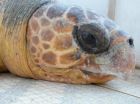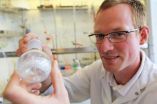(Press-News.org) Biologists worldwide subscribe to the healthy herds hypothesis, the idea that predators can keep packs of prey healthy by removing the weak and the sick. This reduces the chance disease will wipe out the whole herd, but could it be that predators can also make prey populations more susceptible to other predators or even parasites? Biologists at the Georgia Institute of Technology have discovered at least one animal whose defenses against a predator make it a good target for one opportunistic parasite. The research appears online in the journal Functional Ecology.
"We found that strategies that prey use to defend themselves against predators can increase their susceptibility to infection by parasites," said Meghan Duffy, assistant professor in Georgia Tech's School of Biology.
Duffy, along with colleagues at the University of Illinois at Urbana-Champaign and Indiana University, took a look at a small aquatic crustacean, Daphnia dentifera, a water flea known to be an important part of freshwater ecosystems. They exposed the crustacean to chemicals emitted by one of its predators, a phantom midge larva known as Chaoborus, known to feed on it. When the Daphnia detected those chemicals it grew larger, making it harder for its predator to get its mouth around it.
"Unfortunately for the Daphnia, this defense against predation makes them more vulnerable to parasitism," said Duffy.
That's because while growing larger keeps Daphnia safe from Chaoborus, it actually makes it more susceptible to a virulent yeast parasite, known as Metschnikowia. When Daphnia senses a threat from its predator and grows larger, it ends up consuming more of these parasitic yeasts than it does when normal size. When the yeast infects the crustacean, it kills it, causing the dead animal to release yeast spores as it decomposes. The larger the host, the more spores it releases back into the water to prey on other Daphnia.
"Since they need to grow larger to defend themselves against the predator but the opposite to defend against the parasite, they're sort of stuck between a rock and a hard place," she added.
Duffy reasons that this occurs because the predators are common year-round, while the parasites are more episodic in nature, with their populations expanding in epidemics only in the fall and not even yearly. This results in long periods of predation in the absence of the parasite, which probably explains why they respond so strongly to defend themselves against the predator even though it decreases their defenses against the yeast, she added.
"While some have argued for increasing predator densities to control disease, our results suggest that it is important to consider the indirect effects of predators, such as the one we found in which trying to avoid one enemy increases the hosts vulnerability to another," said Duffy.
INFORMATION:
This research was funded by the National Science Foundation.
Scientists uncover an unhealthy herds hypothesis
2011-06-24
ELSE PRESS RELEASES FROM THIS DATE:
Qld fruit fly scientists in race against time
2011-06-24
Parts of Australia's fruit and vegetable industry are under threat, with Queensland University of Technology (QUT) scientists racing to find new ways to control a major horticultural pest before chemical treatments are restricted.
Associate Professor Anthony Clarke, from QUT's Faculty of Science and Technology in Brisbane, is leading Australia's largest team of university researchers examining non-chemical based ways to fight fruit flies, including promising "lure and kill" techniques using ginger essence.
Professor Clarke, lead author of the largest ever review of ...
Cassini samples the icy spray of Enceladus water plumes
2011-06-24
The NASA/ESA/ASI Cassini-Huygens mission has directly sampled the water plumes jetting into space from Saturn's moon Enceladus. The findings from these fly-throughs are the strongest evidence yet for the existence of large-scale saltwater reservoirs beneath the moon's icy crust.
Enceladus' water plumes shoot water vapour and tiny grains of ice into space. They originate from the 'tiger stripe' surface fractures at the moon's south pole, and create the faint E-ring, which traces the orbit of Enceladus around Saturn.
The Cassini spacecraft discovered the plumes in 2005 ...
Debenhams Reveals Parents Need 'Nestoration' When Children Leave Home
2011-06-24
Debenhams has revealed that parents are stockpiling cash for investment in a range of household improvements after their children have gone to University in the autumn or left home, according to a poll carried out by the high street retailer.
Debenhams quizzed 1,000 parents with teens and asked them when they were likely to invest significant sums in redecorating or refurnishing their homes. The department store found that 74% of parents, battered by the costs of raising their kids, were planning to hold on to their cash and refurbish their homes after their kids have ...
Exeter study brings brain-like computing a step closer to reality
2011-06-24
The development of 'brain-like' computers has taken a major step forward today with the publication of research led by the University of Exeter.
Published in the journal Advanced Materials and funded by the Engineering and Physical Sciences Research Council, the study involved the first ever demonstration of simultaneous information processing and storage using phase-change materials. This new technique could revolutionise computing by making computers faster and more energy-efficient, as well as making them more closely resemble biological systems.
Computers currently ...
Exeter study reveals US turtles' movements
2011-06-24
A University of Exeter team has monitored the movements of an entire sub-population of marine turtle for the first time. The study confirms that through satellite tracking we can closely observe the day-to-day lives of marine turtles, accurately predicting their migrations and helping direct conservation efforts.
Writing in the journal Diversity and Distributions, lead author and University of Exeter PhD student Dr Lucy Hawkes (now at Bangor University) describes the migrations of a population of loggerhead turtles in the US Atlantic Ocean over a decade (1998�). ...
iFund Lending Announces New $2 Million Lending Facility for Entrepreneurs
2011-06-24
iFund Lending is pleased to announce that it has made an additional $2 million available in its lending facility for western Canadian entrepreneurs and companies requiring a prudent financing alternative to banks, credit unions and other alternative lenders. iFund Lending provides entrepreneurs with business loans, bridge financing, franchise acquisition, purchase-order financing, debt consolidation, re-mortgages, SR&ED and receivables factoring, and other proven asset-based alternative methods of financing. Borrowers are able to access between $25,000 and $1 million, ...
'Language tests being misused' -- new study
2011-06-24
A seminal article on language testing, co-authored by Dr Glenn Fulcher, a Reader in Education at the University of Leicester, argues that some agencies are using unsuitable language tests to achieve policy ends.
Dr Fulcher, and Professor Fred Davidson of the University of Illinois Department of Linguistics, argue that generic tests are being used for multiple purposes because some policy makers go for "cheap and simple solutions" to complex problems, such as immigration.
Their article, entitled Test architecture, test retrofit, which has won this year's Best Paper ...
Tampa Swingers Announce Two Hotel Takeovers
2011-06-24
Swinglifestyle, the largest swingers site has teamed up to sponsor two hotel takeovers with Tampa Bay Escapes and Hedo Parties. The first event is Tampa Bay Escapes 3, which Tampa Swingers have scheduled for July 28-31,2011 (Thursday - Sunday).
Tampa Bay Escapes 3 is a 3 day / 3 night Complete Hotel Takeover and convention, with 15 Great Play Rooms & Hospitality Rooms, Libation Room every night courtesy of SwingLifeStyle.com. Prizes and Travel give-aways will also be included in the event. TBE has a Great line-up of entertainment and activities, plus TBE's signature ...
Chemist solves riddle of killer diseases
2011-06-24
Anthrax, septicemia and meningitis are some of the planet's most deadly infections. In part because doctors lack basic insights to prevent and cure diseases caused by so called Gram-positive bacteria. Now, a chemist from the University of Copenhagen has revealed the mechanism behind these deadly infections.
By creating a synthetic version of a Gram-positive bacterial endotoxin, Danish synthetic chemist Christian Marcus Pedersen has made a contribution that'll compel immune biologists to revise their textbooks. More importantly, he has paved the first steps of the way ...
Drug side effect linked with increased health risks for over 65s
2011-06-24
A side effect of many commonly used drugs appears to increase the risks of both cognitive impairment and death in older people, according to new research led by the University of East Anglia (UEA).
As part of the Medical Research Council's Cognitive Function and Ageing Studies (CFAS) project, the study is the first systematic investigation into the long term health impacts of 'anticholinergic activity' – a known potential side effect of many prescription and over the counter drugs which affects the brain by blocking a key neurotransmitter called acetylcholine. The findings ...




